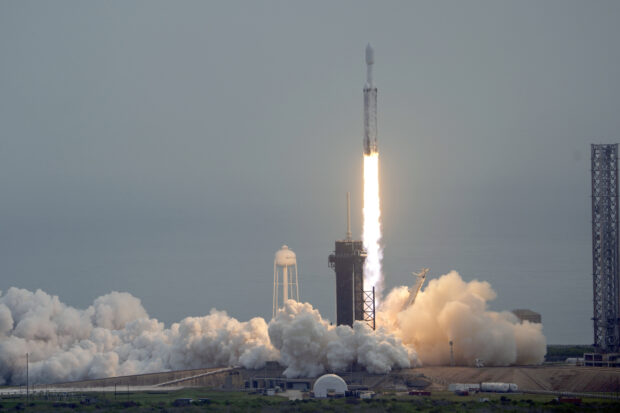NASA spacecraft launched to mysterious, rare metal asteroid in first mission of its kind

A SpaceX Falcon Heavy rocket lifts off from Launch Pad 39A at the Kennedy Space Center in Cape Canaveral, Fla., Friday, Oct. 13, 2023. The spacecraft will travel to the metallic asteroid Psyche, where it will enter orbit in 2029 and be the first spacecraft to explore a metal-rich asteroid. (AP Photo/John Raoux)
CAPE CANAVERAL, Florida — NASA’s Psyche spacecraft rocketed away Friday on a six-year journey to a rare metal-covered asteroid.
Most asteroids tend to be rocky or icy, and this is the first exploration of a metal world. Scientists believe it may be the battered remains of an early planet’s core, and could shed light on the inaccessible centers of Earth and other rocky planets.
SpaceX launched the spacecraft into an overcast midmorning sky from NASA’s Kennedy Space Center. Named for the asteroid it’s chasing, Psyche should reach the huge, potato-shaped object in 2029.
“It’s so thrilling,” said Laurie Leshin, director of NASA’s Jet Propulsion Laboratory. Added Arizona State University’s Jim Bell, part of the Psyche team: “What a great ride so far.”
An hour later, the spacecraft separated successfully from the rocket’s upper stage and floated away, drawing applause from ground controllers.
After decades of visiting faraway worlds of rock, ice and gas, NASA is psyched to pursue one coated in metal. Of the nine or so metal-rich asteroids discovered so far, Psyche is the biggest, orbiting the sun in the outer portion of the main asteroid belt between Mars and Jupiter alongside millions of other space rocks. It was discovered in 1852 and named after Greek mythology’s captivating goddess of the soul.
“It’s long been humans’ dream to go to the metal core of our Earth. I mean, ask Jules Verne,” lead scientist Lindy Elkins-Tanton of Arizona State University said ahead of the launch.
“The pressure is too high. The temperature is too high. The technology is impossible,” she said. “But there’s one way in our solar system that we can look at a metal core and that is by going to this asteroid.”
READ: Chandrayaan-3 spacecraft lands on moon in ‘victory cry’ of new India
Astronomers know from radar and other observations that the asteroid is big — about 144 miles (232 kilometers) across at its widest and 173 miles (280 kilometers) long. They believe it’s brimming with iron, nickel and other metals, and quite possibly silicates, with a dull, predominantly gray surface likely covered with fine metal grains from cosmic impacts.
Otherwise, it’s a speck of light in the night sky, full of mystery until the spacecraft reaches it after traveling more than 2 billion miles (3.6 billion kilometers).
Scientists envision spiky metal craters, huge metal cliffs and metal-encrusted eroded lava flows greenish-yellow from sulfur — “almost certain to be completely wrong,” according to Elkins-Tanton. It’s also possible that trace amounts of gold, silver, platinum or iridium — iron-loving elements — could be dissolved in the asteroid’s iron and nickel, she said.
“There’s a very good chance that it’s going to be outside of our imaginings, and that is my fondest hope,” she said. Believed to be a planetary building block from the solar system’s formation 4.5 billion years ago, the asteroid can help answer such fundamental questions as how did life arise on Earth and what makes our planet habitable, according to Elkins-Tanton.
On Earth, the planet’s iron core is responsible for the magnetic field that shields our atmosphere and enables life. Led by Arizona State University on NASA’s behalf, the $1.2 billion mission will use a roundabout route to get to the asteroid. The van-size spacecraft with solar panels big enough to fill a tennis court will swoop past Mars for a gravity boost in 2026. Three years later, it will reach the asteroid and attempt to go into orbit around it, circling as high as 440 miles (700 kilometers) and as close as 47 miles (75 kilometers) until at least 2031.
READ: Japan launches rocket carrying lunar lander and X-ray telescope to explore origins of universe
The spacecraft relies on solar electric propulsion, using xenon gas-fed thrusters and their gentle blue-glowing pulses. An experimental communication system is also along for the ride, using lasers instead of radio waves in an attempt to expand the flow of data from deep space to Earth. NASA expects the test to yield more than 10 times the amount of data, enough to transmit videos from the moon or Mars one day.
The spacecraft should have soared a year ago, but was held up by delays in flight software testing attributed to poor management and other issues. The revised schedule added extra travel time. So instead of arriving at the asteroid in 2026 as originally planned, the spacecraft won’t get there until 2029.
That’s the same year that another NASA spacecraft — the one that just returned asteroid samples to the Utah desert — will arrive at a different space rock as it buzzes Earth.